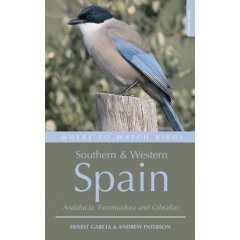
 So, back here fresh from freezing my ass off on my annual visit to England for the Rutland Bird Fair (the Andalucía stand on the left here) and to the East Yorkshire coast where I have never had such a poor visit, although I did see a flock of 21 or so Wood Sandpipers coming in from the direction of Norway which was very nice and visited my first birding home at Filey Brigg (photo right).
So, back here fresh from freezing my ass off on my annual visit to England for the Rutland Bird Fair (the Andalucía stand on the left here) and to the East Yorkshire coast where I have never had such a poor visit, although I did see a flock of 21 or so Wood Sandpipers coming in from the direction of Norway which was very nice and visited my first birding home at Filey Brigg (photo right).
I also took with me 70 or so sheets of illustrations for the seabird book and passed them over to the publisher. And just in case someone out there is doubting, here is a draft of the cover with the working title (photo by Jesús Menéndez, set up by Jorge Garzón).
So, now back along with the new Olympus 590-UZ which gives me 26x optical zoom boosted to 40x with the 1.7x attachment, I trotted off early to the Guadalhorce this morning to meet Bob Wright and we also met Patricia and Paco Rivera of the domingueros. Not that there was a lot to see, there was that sort of dead feeling, and we first went in search of waders along the ponds on the eastern side.
 There was something at least, a Booted Eagle in eucalyptus trees in the mid distance, a bundle of least 50 Stilts, 2 each of Redshank, Dunlin and Common Sandpiper, 3 Sanderling and singles of Knot on the laguna grande (photo taken against the light), Bar-tailed Godwit and Little Stint, plus all three small plovers. As they say, algo es mejor que nada and that made 11 spp. of waders.
There was something at least, a Booted Eagle in eucalyptus trees in the mid distance, a bundle of least 50 Stilts, 2 each of Redshank, Dunlin and Common Sandpiper, 3 Sanderling and singles of Knot on the laguna grande (photo taken against the light), Bar-tailed Godwit and Little Stint, plus all three small plovers. As they say, algo es mejor que nada and that made 11 spp. of waders.So we trotted round to the laguna grande and looked at the massed gulls - all Black-headed and Lesser Black-backs along with 1 Mediterranean Gull. A harrier made an brief appearance and vanished into the clear blue yonder and then a Spoonbill appeared from behind the tamarisks, remained just long enough to read its colour rings before wandering back out view, while three more Spoonbills flew in and promptly hid, bless the little dears.

Thanks to the super-efficient Otto Overdijk of the Spoonbill Working Group in Holland, I already have the sightings history of this bird. It was ringed in May 2005 in Holland and was not seen again until April and May 2007 in Vlieland (Holland) and between 9 May 2007 and 29 July flew to the Banc d'Arguin, Mauritania, a distance of over 4.000 kms, where it obviously spent the winter as it was seen there twice more during winter 2007-08, and was there again in November 2008, presmably having returned to Holland for the summer but not having been seen. The record of this morning would ndicate that once more it is heading south. Hence the value of reading and informing of any colour ringed birds. If you click on the photo to enlarge it, it is possible to see the rings but not read them, for that reason God invented telescopes!
 Now is the time when the Woodchat Shrikes are moving out amd while the adults are now extremely scarce, there are still quite a few juvs. around, which look nothing like the adults so one has to use the jizz to help the identification, the pronounced scaling on the back and shadow of a mask helping with the identification, as this photo shows.
Now is the time when the Woodchat Shrikes are moving out amd while the adults are now extremely scarce, there are still quite a few juvs. around, which look nothing like the adults so one has to use the jizz to help the identification, the pronounced scaling on the back and shadow of a mask helping with the identification, as this photo shows.PARA MAISA: Por favor, escribame a mi dirección privada: andy.birds@gmail.com





